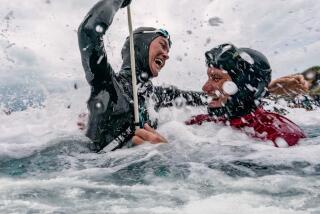3 True Grit Adventures : Bungee Jumping in New Zealand
- Share via
QUEENSTOWN, New Zealand — The waiting line on the old railway bridge winds through a tangle of bungee cords and scaffolding that shield us from New Zealand’s Kawarau River, 143 feet below. Thank God. I’m about to jump off this thing with a woven rubber rope tied to my ankles and if I look down again, I’ll never do it.
“Hey, mate, hear about the guy who got killed in Auckland?” asks the Australian behind me.
“Ah, no,” I say.
“Yea, well, he jumped without the bungee cord attached. Splat on the ground.”
“Any more good news, mate?”
Well this is Queenstown, I reason, and the jump’s operator, A.J. Hackett--who perfected the technique with jumps off the Eiffel Tower and other landmarks--has a reputation for safety.
“No one’s been killed here,” the girl in the office told me before I paid my $50, signed a disclaimer and had my weight recorded on my hand.
“Well, if the cord did break and I fell into the water what would happen?” I ask.
“Probably break some limbs; but don’t worry, the cord won’t break.”
I found myself standing here in line with a group of other tourists--many from California--because a New Zealand friend had suggested I drop by and watch this craziness in the place considered to be the most beautiful bungee-jumping spot in New Zealand.
My friend had not expected me to join the steady stream of humanity which jumps, 9 a.m. to 5 p.m. daily, one every five minutes except during the operators’ lunch break. Had she dreamed I would do such a thing, she says now, she would not have suggested I come.
It would have been easy enough for me to find on my own, though. Bungee jumping has been popular in New Zealand for about three years and although advertising is minimal, any Queenstown shop owner can tell you how to get to the jump site, which is 15 minutes from downtown.
The current craze of jumping off bridges, buildings and hot-air balloon baskets to bounce at the end of a bungee cord is based on a vine-jumping rite of manhood practiced on the Pentecost Island in the South Pacific.
The popularity of the current version is generally attributed to publicity about the exploits of the Dangerous Sports Club of Oxford University, England, whose members, dressed in tuxedos, jumped from bridges about a decade ago.
Bungee jumping is legal in New Zealand. Although there are no specific laws against it in California, jumpers can be cited for a variety of offenses including trespassing and public nuisance.
Legal or not, bungee jumping the world over is pretty much the same: Jumpers are weighed to determine which of several cords will be used to stop their fall and their ankles are strapped into heavy fabric-and-Velcro bracelets that are attached to a long cord generally hooked to a bridge.
Hackett brought the Velcro version back to New Zealand after he and a friend jumped from the Eiffel Tower in 1987.
As I wait to jump, it’s hard not to worry. I tell myself I do more dangerous things all the time, like driving on the freeway after midnight, or flying. And I’m not up here to prove anything; it just looks exhilarating. Still, I hear my mother’s voice: “If everyone else was jumping off a bridge, would you?”
From a radio George Thoroughgood sings “Down, down, down,” and I listen to the college-age workers harnessed to the bridge instruct the next jumper. “We’ll count down from five and then you jump. Then reach for the horizon, like you’re going to grab it.”
He jumps at “one.” The clank and taut tug on the bungee hoist in front of me tell me he’s made it.
I’m next. A worker called Johnny asks me if I’m nervous. I lie. He trusses my ankles in a blue towel and heavy vinyl cord that hooks on the bungee. It’s so tight I have to hop into the outline of feet on the edge of the jumper’s platform; I’m afraid I’ll fall right off. Painted next to my feet is the question, “Are you ready to fly?” I’m not amused.
I look down for the first time and I cower. I’m dizzy, disoriented; so this is vertigo. It seems higher than I imagined. I mean there’s nothing between me and the river 143 feet below. I’ve made a mistake. Terror, like nothing I’ve ever felt, grips my body: I’m breathless, my heart flutters, my digestive system verges on betrayal. I feel faint, very faint.
“OK, Tom, remember, reach for the horizon.” I’m too scared to speak, but my mind is racing: No, no, I’m not ready to do this. Excuse me, can I have some more time to think about this? Try to relax, think it through. It’s so pretty up here, with all the trees and open air. JEEEEEEEEEEEZ! Pretty, man; you’re about to jump down there. I’ll give you pretty.
Five . . .
Oh no, don’t start counting. Please, God! I’m an idiot. I can’t believe I’m up here. Just don’t faint.
Four . . .
Oh, you can’t be thinking of jumping from THIS. It is really HIGH, YOU MORON! YOU’RE GOING TO DIE! Tomorrow they’ll be asking your grieving family for your dental records. Nice going, Bozo.
Three . . .
Oh damn it, the cord. Did they connect the cord? Oh, Jeez, you were supposed to check that.
Two . . .
This is it idiot. You wanted to do it. Just close your eyes and go; one way or another it’ll be over in a few seconds. Still, you’re a moron. Big time.
One . . .
I jump immediately. I reach for the horizon. I don’t scream. I can’t, I can hardly breathe. Your heart makes funny, loud thumps when you jump off a bridge. “I’ve just jumped off a bridge.” I say it two times and I don’t think about the cord at all, I think I’m going to die before I even get to the bottom. And I’m moving, like a falling rocket. I can feel the air resisting, like water skiing. So this is free fall. Wow.
It takes about three seconds to reach the bottom. Somewhere between wow and the water, I get thinking about gravity as a finite force. When’s this thing going to catch me!!!
And it happens, the cord yanks me back up, easy and high. For a moment, I think I’m going to hit the bridge and I start to fall again, a messy bundle of limbs, but relieved and elated. I bounce up and down as if on a trampoline until I come to rest upside down, like a plucked chicken, and wait for the rescue dinghy to take me ashore. It’s over that easy. All of it, except for a buzz that lasts for days.
“Was it great?” a woman asks in the office.
“It was wonderful,” I say.
“Would you do it again?”
“Not a chance. Do I look like I’m crazy?”
More to Read
Sign up for The Wild
We’ll help you find the best places to hike, bike and run, as well as the perfect silent spots for meditation and yoga.
You may occasionally receive promotional content from the Los Angeles Times.






